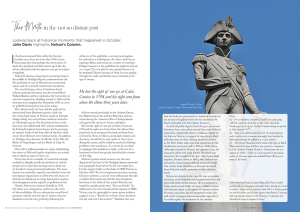Looking back at historical moments that happened in October, John Davis highlights Nelson’s Column.

It has been estimated that within the Greater London area, there are more than 1500 statues. Interesting then that perhaps the most iconic of them all is perched over fifty metres up in the sky, where effectively only the pigeons ever get to inspect it regularly.
Nelson’s Column, occupying its central position in the middle of Trafalgar Square, commemorates the life and death of one of Britain’s most renowned sailors and the sea battle which led to his demise.
The overall design, a base, Corinthian fluted column, pedestal and statue was the brainchild of William Railton and was selected as the best entry in a national competition. Building started in 1840 and the structure was completed by November 1843 at a cost of £42,000 (estimated at over £5m today).
The column itself, the base and the pedestal are constructed from Dartmoor granite, while the five-metre-high statue of Nelson, made by Edward Hodges Baily, was carved from sandstone mined in an Edinburgh quarry. The four bronze lions at the base were not added until 1867 and are attributed to Sir Edward Landseer better known for his paintings of animals. Each of the four sides of the base show scenes from Nelson’s most famous battles. In addition to Trafalgar, they illustrate the Battle of the Nile, the Battle of Copenhagen and the Battle of Cape St. Vincent.
Over half a million pounds was spent refurbishing the statue in 2006 and regular inspections are carried out to check on signs of wear. (1)
There have been a number of successful attempts to climb it, illegally, usually by members of activist groups keen to get their message across from one of London’s most prominent landmarks. The most famous was probably staged by two climbers from the Greenpeace organisation in 2016 when the statue of Nelson was kitted out in a large facemask to register their disapproval at the capital’s air pollution levels.
Horatio Nelson was born in Norfolk in 1758. His father was a clergyman, and he was the sixth of eleven children. He was educated at several local grammar schools until the age of twelve, when he decided to join the navy, probably following the influence of his godfather, a serving naval captain. He enlisted as a midshipman, the lowest rank for an aspiring officer, and served on a variety of warships. Perhaps because of his godfather, he might be classed as a ‘nepo’ (2), or maybe he was spotted because of his potential. Maybe because of both, he rose quickly through the ranks and had his own command at the age of twenty.
Nelson served particularly in the Atlantic Ocean, the Mediterranean Sea and the Baltic Sea and saw action during the American War of Independence and against the navies of France and Spain.
He lost the sight of one eye at Calvi, Corsica in 1794 and his right arm from above the elbow three years later in an unsuccessful attack on Santa Cruz in Tenerife. Bouts of illness, particularly malaria and dysentery, forced him to take spells of shore leave during his career, and he failed to master his lifelong problems with seasickness. As a result, he resorted to napping in his armchair at night, as the use of a hammock or bunk too greatly mimicked the motion of the ship.
Nelson’s greatest naval successes are the ones depicted on the base of his Trafalgar Square memorial (see paragraph four) before his life was ended by a French sniper’s bullet on the deck of HMS Victory in October 1805. Was his conspicuous position, wearing full dress uniform, a case of over-enthusiastic bravado or did he feel it necessary that his men should see him there in the thick of the action? That the last words he actually spoke were, “Kiss me Hardy” (3), addressed to his close friend and the captain of HMS Victory, may be apocryphal as more recent evidence suggests it was, “Thanks be to God, I have but lived this day and now I die content.”
Tradition also says that his body was preserved in a barrel of brandy for the return to England where he was interred in St. Paul’s Cathedral with full military honours.
As with all public figures from the past, revisionist historians have since taken several bites into Nelson’s reputation. Apparently, there is evidence, mainly in the form of letters, to suggest he was closely allied with the cause of slave owning plantation bosses in the West Indies and expressed opposition to the abolitionist movement led by William Wilberforce. Although married to Frances for eighteen years, his long-term affair with Lady Emma Hamilton was classed as ‘the scandal of the day’. They had a child together, Horatia (born in 1801), who Nelson was devoted to. Government officials ensured though that neither Lady Hamilton or Horatia benefited from Nelson’s wealth, pensions or titles after his death.
Nelson was known to be vain. He was a complex character, easily flattered and disappointed when not given full credit for his actions. He was however a highly professional leader of men, a skilled seaman who became adept at all aspects of marine combat. On many occasions, he was prepared to take risks and switch strategies unconventionally especially if he could exploit the weakness of his enemies.
Notes:
(1) For an hilarious example of health and safety going AWOL watch the short film on You Tube where John Noakes goes to the top of Nelson’s Column during an episode of Blue Peter in 1977.
(2) Nepo is an abbreviated version of the word nepotism and is used to refer to someone who might have benefited in their career through the influence of a close relative.
(3) The Hardy Monument which stands 22m high on Black Down near Portesham in Dorset was erected as a memorial to Vice Admiral Thomas Hardy of Nelson fame who was captain of HMS Victory. It is not connected to the famous author of the same name who included Dorset (Wessex) in many of his novels.




